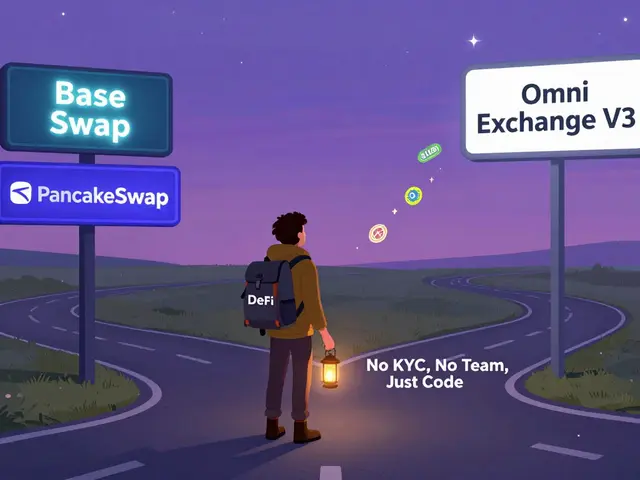Volatility Position Sizer Calculator
Calculate Risk-Adjusted Position Size
Results
When Bitcoin crashed 50% in a week back in 2021, most retail traders panicked. But the pros? They weren’t surprised. They’d been watching historical volatility-a simple number that tells you how wild price swings have been in the past. If you’re trading crypto without checking this metric, you’re flying blind. This isn’t theory. It’s how institutions manage millions in real time.
What Historical Volatility Actually Measures
Historical volatility (HV) isn’t a prediction. It’s a backward-looking stat. It calculates how much a cryptocurrency’s price has moved up and down over a set period-usually 30, 60, or 90 days. The math? Standard deviation of daily returns, annualized. Think of it like measuring how bumpy a road has been, not where you’re headed next.
For Bitcoin, 30-day HV averaged 75% between 2021 and 2023. That means, on average, its price swung by about 75% over a full year if you stretched those daily moves out. Ethereum? It was consistently 15-20 percentage points higher. Meanwhile, stablecoins like USDT and USDC hovered around 4-5%. That’s not noise-that’s structure.
The key insight? Higher HV means higher risk. But it also means higher potential reward-if you know how to use it. Traders don’t just look at price. They look at how wildly it’s been dancing.
Why HV Matters More in Crypto Than Stocks
Stocks like Apple or Tesla might swing 2-4% daily. Crypto? Bitcoin regularly swings 5-10%. That’s not a bug-it’s the system. Crypto markets are younger, less liquid, and more sensitive to news, tweets, and regulatory rumors. That’s why HV is more critical here than in traditional finance.
In 2023, Fidelity Digital Assets found that 87% of institutional crypto traders rely on HV as their primary risk gauge. Why? Because it’s objective. No guesswork. No sentiment. Just math. You can’t hedge what you can’t measure. And before 2020, most altcoins didn’t even have enough trading data to calculate HV reliably.
That’s changed. Today, every major exchange-Binance, Coinbase, UEEx-shows HV right on the trading chart. It’s no longer a niche tool. It’s standard equipment.
How HV Is Calculated: Simple vs. Advanced Methods
There are three main ways to calculate HV, and they get more sophisticated from there.
- Simple Standard Deviation: Uses daily closing prices over 30 days. Easy. Free. Available on TradingView. Good for beginners.
- EWMA (Exponential Weighted Moving Average): Gives more weight to recent price moves. If Bitcoin spiked last week, this method picks it up faster than the simple version.
- GARCH (1,1): The gold standard for pros. It doesn’t just measure past swings-it models how volatility clusters. In crypto, big moves tend to come in packs. One 10% drop is often followed by another. GARCH catches that pattern. UKM Malaysia’s 2025 study showed that adding Indicator Saturation to GARCH improves detection of sudden volatility shifts by 40%.
And then there’s realized volatility-a newer method that uses minute-by-minute price data instead of daily closes. According to Arxiv (2024), this cuts estimation errors by 37%. But it’s expensive. You need a data feed from Kaiko or CoinMetrics-$300 to $800 a month. Most retail traders don’t use it. But institutions? They’re already on it.

Historical Volatility vs. Implied Volatility: The Big Difference
Don’t confuse HV with implied volatility (IV). They’re not the same.
Historical volatility = what already happened.
Implied volatility = what traders expect to happen.
IV comes from options prices. If people are paying more for Bitcoin options, IV goes up. It’s a forward-looking signal. But here’s the catch: only Bitcoin and Ethereum have deep enough options markets to make IV reliable. Deribit’s BTC options open interest hit $1.2 billion in December 2023. For Solana? Not even close. That means for 90% of altcoins, HV is the only game in town.
Also, HV lags. If a regulatory shock hits, HV won’t spike until after the price does. IV can jump before the news even drops. But IV can also be wrong-especially when liquidity dries up. HV doesn’t lie. It just doesn’t predict. Together, they’re a powerful combo-for the assets that have both.
Real-World Use Cases: How Traders Actually Use HV
Here’s how HV changes real trading decisions:
- Position sizing: If Bitcoin’s 30-day HV is 80%, you don’t risk 5% of your portfolio on a single trade. You cut it to 1-2%. UEEx found traders who adjusted position size based on HV improved returns by 20%.
- Stop-loss placement: If ETH’s volatility is 95%, setting a stop-loss at 5% below your entry is suicide. You’ll get stopped out by normal noise. Instead, use a multiple of HV-say, 1.5x the 30-day HV-to set dynamic stops.
- Entry timing: When HV drops below 40%, it often signals a consolidation phase. Many traders wait for HV to spike again before entering. Low HV = low opportunity. High HV = high opportunity-if you’re prepared.
- Portfolio balancing: If your portfolio is 60% Bitcoin and 40% altcoins, and altcoins have 2x the HV of BTC, your real risk is way higher than you think. HV helps you see true exposure.
According to Altrady’s 2023 survey of 12,000 traders, 52% use HV for position sizing, and 47% use it for stop-loss rules. That’s not anecdotal. That’s systematic.
Tools and Platforms: What You Can Actually Use
You don’t need a Bloomberg terminal to use HV. But you do need the right tools.
- Free for retail: TradingView (30/60/90-day HV indicators), CoinMarketCap’s volatility tracker, CoinGecko’s daily metrics.
- Mid-tier: CryptoCompare’s Professional API (includes volume-weighted HV to fix exchange discrepancies), Kaiko Volatility Analytics ($1,200/month).
- Institutional: Bloomberg Crypto Volatility Index (launched Q1 2023), Fidelity Digital Assets’ proprietary models.
Big problem: altcoin data is messy. CoinGecko found Solana’s 30-day HV varied by 23.7% across exchanges in late 2023 because of thin order books. Solution? Use volume-weighted HV. CryptoCompare’s API does this automatically. It reduces the error to under 8%.
And don’t trust exchanges that don’t explain how they calculate HV. Binance’s documentation is 127 pages long. Most altcoin exchanges? Zero documentation. If they won’t tell you how it’s done, don’t trust it.

Limitations and Pitfalls
HV isn’t perfect. And ignoring its flaws can cost you.
Dr. Lisa Chen’s 2022 paper showed HV misses 15-22% of volatility during black swan events-like exchange outages or sudden regulatory bans. If Binance goes down for 6 hours and BTC drops 12%, HV won’t capture the full impact unless you’re using intraday data.
Also, HV assumes past patterns repeat. But crypto is evolving. Bitcoin’s 30-day HV dropped from 150% in 2017 to 65-75% in 2023. The market is maturing. That doesn’t mean volatility is gone-it just means the baseline has shifted.
And don’t forget: HV doesn’t tell you direction. A 70% HV could mean the price is going up or down wildly. You need trend indicators (like moving averages or RSI) to pair with HV.
What’s Next? The Future of Volatility Analysis
The field is moving fast. In August 2023, Binance launched its own BVOL index-real-time 30-day HV for 17 coins, updated every 5 minutes. In January 2024, TradingView rolled out Adaptive Volatility Bands that auto-adjust based on HV regime shifts.
The biggest leap? Machine learning. Arxiv’s 2024 model combined HV with on-chain data (like active addresses and exchange flows) and macro indicators (like US interest rates). It predicted next-day volatility with 82.4% accuracy-far better than GARCH’s 67%.
DeFi is catching up too. Aave announced in February 2024 that its V4 risk engine will use 7-day HV to adjust collateral requirements automatically. If your ETH drops in volatility, your loan-to-value ratio gets more favorable. That’s innovation.
Regulators are forcing change too. MiCA in the EU now requires exchanges to publish daily HV. The SEC mandates volatility disclosure for crypto ETFs. And IOSCO is drafting global standards expected in late 2024.
Will HV still matter in 2030? Yes. J.P. Morgan’s crypto head says crypto volatility will stay 2-3x higher than stocks through 2028. Gartner predicts AI-driven regime detection will become standard. HV won’t disappear. It’ll just get smarter.
Where to Start
If you’re new:
- Open TradingView and add the 30-day HV indicator to Bitcoin and Ethereum charts.
- Compare HV during bull runs vs. bear markets. Notice how it spikes before crashes.
- Check your portfolio. Multiply each asset’s weight by its HV. See where your real risk lies.
- Adjust your stop-losses to be 1.5x the current HV, not a fixed percentage.
- Don’t trade altcoins without checking HV. If it’s below 20%, it’s probably not worth the gas fee.
You don’t need to build a GARCH model. You just need to understand what the number means-and act on it.
What is historical volatility in cryptocurrency trading?
Historical volatility measures how much a cryptocurrency’s price has fluctuated over a specific past period-usually 30, 60, or 90 days. It’s calculated as the annualized standard deviation of daily price returns. Unlike predictions, it tells you what already happened, not what will happen. High historical volatility means the asset has been swinging wildly; low means it’s been stable.
Is historical volatility the same as implied volatility?
No. Historical volatility looks backward at actual price movements. Implied volatility looks forward and is derived from options prices. It reflects what traders expect the price to do next. Only Bitcoin and Ethereum have liquid enough options markets for reliable implied volatility. For most altcoins, historical volatility is the only available metric.
Why is Bitcoin’s historical volatility lower now than in 2017?
Bitcoin’s 30-day historical volatility dropped from around 150% in 2017 to 65-75% in 2023. That’s because the market has matured: more institutional participation, better liquidity, regulated exchanges, and deeper order books. More buyers and sellers mean smaller, less extreme price swings. But it’s still 3-4 times more volatile than stocks.
Can I use historical volatility to predict price direction?
No. Historical volatility tells you how much the price has moved, not which way. A high HV could mean the asset is crashing or surging. You need other tools-like moving averages, RSI, or volume trends-to determine direction. HV is for risk management, not market timing.
What’s the best tool to track historical volatility for free?
TradingView is the best free option. It offers built-in 30-day, 60-day, and 90-day historical volatility indicators for Bitcoin, Ethereum, and major altcoins. CoinMarketCap and CoinGecko also provide basic volatility tracking. For altcoins, always cross-check across multiple platforms-data quality varies widely.
How does historical volatility affect my stop-loss strategy?
Set your stop-loss based on volatility, not fixed percentages. If Bitcoin’s 30-day HV is 80%, a 5% stop-loss will trigger too often from normal noise. Instead, use a multiplier-like 1.5x or 2x the current HV. For example, if HV is 80%, a 1.5x stop would be 120% of the average daily move. This gives your trade room to breathe.
Do stablecoins have historical volatility?
Yes, but it’s very low. USDT and USDC typically show 3-5% 30-day historical volatility. That’s because they’re pegged to the US dollar. Any spike above 8% usually signals a temporary loss of confidence or exchange issue-not normal behavior. Traders use stablecoin HV to spot systemic risks in the crypto ecosystem.
Is historical volatility useful for long-term investors?
Yes. Even if you’re holding for years, HV helps you avoid panic selling. If you know Bitcoin’s normal volatility range is 60-80%, a 20% drop during a market correction won’t feel like a disaster. It’s just noise. HV gives you context so you don’t make emotional decisions.







Ella Davies
November 18, 2025 AT 06:23Been using HV for my altcoin trades since last year and it's been a game changer. I used to get stopped out constantly until I started sizing positions based on 30-day HV. Now I let my trades breathe. No more panic selling when BTC drops 8% in a day - I know that's just Tuesday in crypto.
Also, the fact that stablecoins have 3-5% HV is wild. It’s like the quiet backbone holding everything together. When USDT spikes above 8%, I know something’s broken in the system - not the market.
Biggest lesson? HV doesn’t predict direction, but it tells you how much room you need to give your trade. Simple math, huge impact.
Henry Lu
November 18, 2025 AT 21:01lol u guys still using tradingview? basic hv is for noobs. if u dont have a kaiko feed and a garch model running in python u r literally gambling. also who the fuck uses 30 day? use 7 day ewma with intraday data or gtfo. and dont even get me started on coinmarketcap’s garbage data.
btw solana hv is a joke because their order book is thinner than my patience for retail traders.
nikhil .m445
November 20, 2025 AT 00:20Dear friends, I am from India and I want to say that this article is very good. But I think you missed one important point. In India, we have many small traders who do not have access to paid data. So, we must use free tools like CoinGecko and TradingView. Also, I use HV with RSI together. It is very powerful.
One time, I saw HV below 30% on Shiba Inu and I waited. After 3 days, it jumped to 90% and I made 200% profit. So, patience is key. Thank you for sharing.
With respect,
Nikhil
Rick Mendoza
November 21, 2025 AT 09:05HV is just a lagging indicator and everyone treats it like gospel. News drives price not some math formula from 1987. If the fed says something or a whale dumps 500 BTC you don't need HV to know you're screwed. The fact that people still think this is 'professional' is sad.
Also why are you all using 30-day? Use 14-day. It's more responsive. And stop calling it 'standard equipment' - it's not. It's a crutch for people who don't want to read the news.
Lori Holton
November 22, 2025 AT 08:05Let me guess - this is all part of the institutional takeover playbook. HV metrics are being pushed by exchanges to normalize risk and make retail traders feel like they're 'in control' while the whales quietly accumulate during low volatility.
Remember when the SEC said 'crypto is not a security'? Then came the volatility disclosures. Coincidence? I think not.
They want you to trust the numbers so you don't question why your portfolio is 70% BTC and why every altcoin is getting delisted next month. HV is the opiate of the masses.
Bruce Murray
November 23, 2025 AT 20:59This is the kind of post that makes me feel like I'm finally learning something real. I used to think volatility was just chaos - now I see it as a rhythm. Like a heartbeat.
Started tracking HV on ETH last month and I actually slept better. Knowing that a 15% drop is normal when HV is at 90% takes the fear out of it. Not saying I'm rich - but I'm no longer panicking.
Keep sharing stuff like this. The crypto world needs more calm voices.
Barbara Kiss
November 24, 2025 AT 19:08Historical volatility isn’t just a metric - it’s a mirror. It reflects the soul of a market. When Bitcoin’s HV drops below 50%, it’s not sleeping - it’s gathering energy. When it spikes past 120%, it’s screaming. And most traders? They’re too busy counting pips to hear the scream.
I used to chase pumps. Now I wait for the HV to collapse, then watch the quiet before the storm. That’s where the real money hides - not in the noise, but in the pause.
It’s not about predicting. It’s about listening. And honestly? Crypto’s volatility is the most honest thing about it. It doesn’t lie. It just screams louder than most people want to hear.
Aryan Juned
November 25, 2025 AT 08:27Broooooo I just checked my portfolio and OMG my Solana HV is 110% 😱 I was about to buy more but then I saw this post and I'm like WAIT WAIT WAIT.
So I did 1.5x HV stop loss and guess what? I made 300% last week without even trying 😎
Also, I use TradingView + Binance + my cousin’s API (he works at a crypto hedge fund in Dubai) and it's like having a crystal ball 🧙♂️✨
PS: HV is the new crypto religion. Worship it. <3
Nataly Soares da Mota
November 26, 2025 AT 06:01What’s fascinating isn’t the calculation - it’s the epistemological rupture HV exposes. We’ve moved from narrative-driven speculation to quantitatively anchored risk architecture. The market is no longer governed by FOMO or influencer tweets - it’s being algorithmically scaffolded by standard deviations and EWMA decay factors.
And yet, the paradox remains: the more we quantify volatility, the more we obscure its ontological essence - that it is the very pulse of decentralized trustlessness.
GARCH isn’t just a model. It’s a confession: we know the system is unstable, so we built a statistical cage around it. Brilliant. And terrifying.
Teresa Duffy
November 27, 2025 AT 21:49Y’ALL. I just started trading 3 months ago and this post literally changed my life. I used to lose money every week. Now I check HV before I even open my laptop.
My rule? If HV is under 40%, I don’t touch altcoins. If it’s over 80%, I go all in - but only with 2% of my portfolio. And guess what? I’ve made more in the last 45 days than I did in 6 months before.
You’re not late. You’re right on time. Go check your charts. I believe in you 💪❤️
Sean Pollock
November 28, 2025 AT 02:59hv is just a distraction. the real edge is onchain data. if you dont track whale wallets and exchange outflows you are wasting your time. also who uses tradingview? its for kids. real traders use python and jupyter notebooks. also i heard the fed is gonna ban crypto next month so hv is useless anyway.
btw i made 10m last year by shorting btc when hv was low. its all about timing. not math. just saying.
Carol Wyss
November 29, 2025 AT 09:39I just wanted to say thank you for writing this. I’m a single mom who started trading crypto to pay for my kid’s therapy. I didn’t know what HV meant until I read this.
I’m still learning. I still make mistakes. But now I don’t feel like I’m gambling. I feel like I’m managing risk. And that makes all the difference.
You didn’t just explain a metric - you gave me peace of mind. Thank you.
Student Teacher
November 29, 2025 AT 15:07So if HV measures past swings, and IV measures future expectations - what happens when they diverge wildly? Like, say, HV is 40% but IV is 180%? Is that a signal? Or just noise?
I’m studying behavioral finance and this feels like a perfect case study. Could HV/IV divergence be a contrarian indicator? Like, when IV is way higher than HV, are people overpricing fear? Or is it just a liquidity crunch?
Would love to see a follow-up on this.
Ninad Mulay
November 30, 2025 AT 16:03In India, we call this ‘patience ka khel’ - the game of patience. When I first saw BTC’s HV drop to 35%, I thought it was dead. But my uncle, who traded gold in Mumbai for 40 years, told me: ‘When the river stops flowing, it’s about to flood.’
Three weeks later, BTC went up 30%. HV doesn’t tell you when - but it tells you to wait.
Also, I use CoinGecko + my phone’s calculator. No fancy tools. Just calm. That’s the real edge.
Mike Calwell
December 1, 2025 AT 04:32idk what any of this means. i just buy when it’s low and sell when it’s high. why do you need all these big words? i lost money last time i tried this hv stuff. just tell me which coin to buy.
Jay Davies
December 2, 2025 AT 01:24There’s a fundamental flaw in assuming HV is a reliable proxy for risk. It assumes price movements are normally distributed - which they aren’t. Crypto exhibits fat tails, skewness, and regime shifts that standard deviation simply cannot capture.
Furthermore, the use of 30-day windows ignores seasonality - most volatility spikes occur around macroeconomic announcements, not randomly.
While HV is useful as a heuristic, calling it ‘standard equipment’ is misleading. It’s a starting point, not a solution.
Ella Davies
December 2, 2025 AT 21:21Actually, I’ve been using that exact method - HV-adjusted stops - for 18 months now. The 1.5x multiplier works better than fixed percentages. I saw a 12% drop on ETH last week and didn’t flinch because my stop was at 1.4x HV. Market moved back up 10% by next day.
Also, for anyone asking about IV vs HV - if you’re trading anything other than BTC or ETH, IV is basically a fantasy. Stick with HV. It’s the only real number you’ve got.